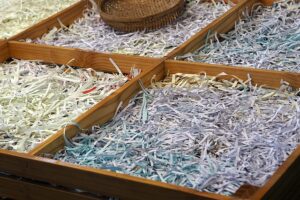With cooler yet mild temperatures, fall is the perfect time to get your home cozy and organized for winter and the holiday season. This may involve catching up on projects that were put on hold in the wake of summer vacations and other warm-weather activities. So, use our fall organizing checklist to help you get it all done.
Disclosure: This blog may contain affiliate links, which means we may earn a commission if you click a link and make a purchase (at no additional cost). We only recommend products and services we use and trust. We aim to provide valuable, trustworthy resources that enhance and simplify your life. You can read our full privacy policy here.
Fall Organizing Outdoors:
This may not be on your checklist, but taking care of things outside is just as important as organizing the inside of your home.
Gardening, Lawn Equipment, and Outdoor Furniture
First, winterize mowers and other motor-driven equipment and clean and properly store tools. Clean outdoor furniture and ensure it’s properly stored to protect it from the elements.

Irrigation Systems, Outdoor Faucets, and Water Features
When water freezes, it expands, causing burst pipes, faucets, and hoses if left unattended. If you’re fortunate enough to have an irrigation system, you must winterize it in colder climates. We recommend calling a professional to perform this task annually, as errors can be costly.
Before the first freeze, disconnect and drain the hoses from outdoor faucets. Store the hoses inside the garage, basement, or shed. Then, use a faucet cover as an extra layer of protection for outdoor faucets. If you have a birdbath and plan to leave it out all winter, use a heating element that is properly installed and safely connected to a power source.
Explore the importance of assessing your fall goals to assist you in staying focused, on your journey: Fall Goals Check In
Gutters and Downspouts
Leaves, pine needles, and other debris get caught in gutters, clogging them. This can lead to winter ice dams and water backups, which may damage your home. If you feel confident doing this yourself, use a good ladder and be careful. Pay close attention to your surroundings. Consider the position of any electrical lines, and avoid placing your ladder on damp or soft ground. If your gutters are higher than you are comfortable climbing, you should call a professional.
Replace Screens with Storm Windows and Doors
Ultimately, removing screens and installing storm windows can make your home more energy-efficient. It’s also a great time to clean and repair screens. If you have older windows, use this opportunity to install shrink-to-fit plastic wrap for an additional layer of energy efficiency.
Increase your productivity, reduce stress, and achieve your goals with these 4 Effective Keys to Time Management
Wash Windows
Since you’re there anyway, this is a great time to wash the inside and outside of your windows. They may not look it, but they’re probably dirtier than you realize.
This window cleaning recipe works great on windows as well.

Inspect the Exterior of Your Home
Look for areas that may allow cold air in. Inspect your foundation for cracks and caulk around where the concrete meets the siding, pipes, and wires enter the home, and around windows and door frames. One of the least costly maintenance tasks is caulking and sealing holes.
Need more help organizing home projects? Check out Homezada. It’s a comprehensive platform designed to streamline home improvement projects. It offers budgeting tools, planning templates for over 40 types of remodels, and robust record-keeping features for tax and resale purposes. The platform is ideal for both DIY enthusiasts and those hiring contractors, providing a one-stop solution for managing costs, timelines, and documentation. It could be a valuable resource for individuals juggling multiple properties or looking to make financially savvy home improvements.
Fall Organizing Inside
Overall, now that the outside of your home is ready, it’s time to organize and get the inside of your house ready for fall.
Smoke Detectors
Inspecting smoke and carbon monoxide (CO) detectors should always be on your fall to-do list. “Each year, more than 400 Americans die from unintentional CO poisoning not linked to fires, more than 100,000 visit the emergency room, and more than 14,000 are hospitalized.” (cdc.gov)
Since you’re less likely to open windows and have adequate ventilation in your home during the fall and winter, you need to take precautions. Batteries should be replaced yearly, and smoke detectors should be replaced at least every ten years. CO detectors should be replaced every five to seven years.
Home Repair and Record Keeper: This organizational tool helps homeowners efficiently manage home repairs, track appliance warranties, and keep contractor contacts. It also offers seasonal maintenance tips and checklists, serving as a practical guide for home upkeep.
Sweep and Inspect Chimneys
Soot and creosote buildup can cause a house fire. To prevent this, your chimney should be cleaned and inspected annually. Don’t do this yourself. Please bring in a pro who knows what they’re looking for. Lastly, if you’ve got a gas fireplace, it should also be inspected.

Ceiling Fans
Take the time now to clean the blades and reverse their direction. In the winter, ceiling fans should rotate clockwise at a low speed. This generates an updraft that circulates heated air throughout the room and is especially effective in areas with vaulted ceilings.
Keep your home running smoothly with these 9 Tips for Creating a Sustainable Home Maintenance Schedule
HVAC Systems
Clean and replace filters so your system is ready for the colder temps. Depending on your system’s age, you may also want to have it professionally inspected to be sure it will run smoothly all winter long without an issue.
Dryer vents
Ultimately, each year, 2,900 dryer fires occur, resulting in an estimated five fatalities, 100 injuries, and $35 million in property loss. More dryer fires happen in the fall and winter, with the peak occurring in January. Clean your dryer and its vents at least once a year—it’s an easy DIY project with a dryer duct cleaning kit.
Examine some TikTok cleaning hacks to avoid – The Truth About TikTok Cleaning Hacks
Fall Organizing and Deep Cleaning
Much like spring cleaning, fall cleaning addresses those places you don’t usually do.
Kitchen
- First, empty and clean both your pantry and fridge. Don’t forget the refrigerator coils! While everything is out, discard any items you can no longer use.
- Take this opportunity to list what you need for holiday baking and entertaining.
- Clean the oven and vent hood, including replacing the vent filter if there is one.
- Wash kitchen cabinets down with mild detergent or degreaser if needed. Oil wood cabinets, remove any excess oil, and buff with a clean cloth.
- Wipe your dishwasher door and gasket to remove any mold. We use Tang (yes, the powdered drink mix) as it removes hard water stains, soap scum, and dishwashing detergent residue. The powdered drink’s citric acid removes mineral deposits and dirt. Tang is cheap, accessible, and non-toxic.
- Thoroughly clean the toaster, microwave (this microwave cleaner is super cute), and other small appliances.
- Last, deep clean your kitchen floor. The floors you have will determine the process and steps you need to take. Please follow the manufacturer’s directions and not the information you see on social media, as they are expensive, wasteful, time-consuming, and hazardous, and will damage the flooring.
Take these steps to help keep your home fully functional when the cooler temps arrive – Getting Your House Ready for Cold Weather

Living Room
- Vacuum upholstered furniture, including under the cushions.
- Clean floors, including under furniture.
- Dust baseboards, shelves, and walls, and remove scuff marks from walls.
- Clean electronic devices, keyboards, and TVs.
- Shake rugs and throw pillows outside, and put the latter in the dryer on low with natural fabric softener; these best sellers remove any excess dust.
Get organized, stay organized, and optimize your time – Organization Apps for Daily Living
Bathroom
- Properly remove mold or mildew: Wash the shower curtain, liner, bathmats, and window treatments.
- Replace toothbrushes and soak makeup brushes.
- Clean out cabinets and safely discard any expired items.
- Clean and disinfect the toilet, shower/tub, and sinks.
- Wash walls and baseboards with a mild cleaner.
- Then, hand wash the bathroom floor (if you can) using the proper cleaner and tools, such as an old toothbrush, to remove stuck-on “gunk,” such as hairspray and grime, under your baseboards.
Bedroom
- First, clean carpets and rugs, including under the bed and other furniture.
- Vacuum and rotate your mattress.
- Put away summer bedding and bring out winter bedding from storage.
- Lastly, wash blankets and other winter bedding. Wash or buy new bed pillows. We LOVE this brand of pillows and have used them for years.
To keep dust mites out of your bedroom, follow these simple steps – Dust mites and Deep Cleaning
Closet
- Store summer clothes and bring your cooler weather items out (Cleaning Your Winter Wardrobe)
- Wash any soiled clothes you plan to store, and donate clothing you no longer wear.
- Then, while your closet is empty, vacuum and inspect for moths or other pests that may ruin your clothes.
Is there an area of your home you’d like to organize for fall but are unsure where to start? Let us know in the comments below, and we’ll do our best to help!
Looking for more? 👉🏻 Check Out More Closet Organizing
Be the First to Know
Get our newsletter filled with practical tips on personal finance, organizing, and productivity. Plus, reviews of our favorite podcast episodes, resources, and books. 🌟 Sign Up for Our Newsletter 🌟 for your gateway to a more organized and financially savvy lifestyle.




